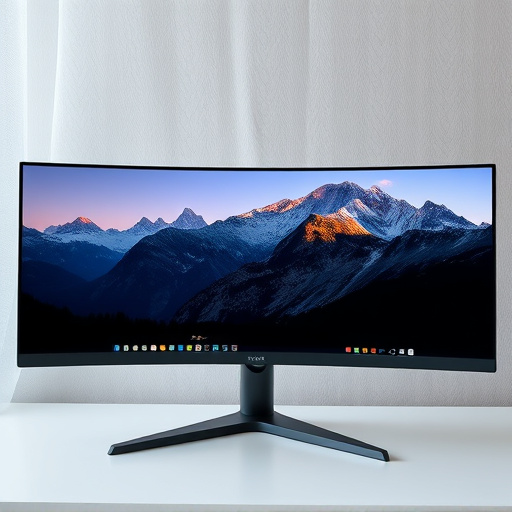Understanding computer display resolution hinges on aspect ratios, which define an image's width-to-height relationship. These ratios significantly impact visual sharpness and content layout, especially with ultra-wide monitors. The demand for ultrawide screens has surged due to their superior resolution and benefits in tasks like photo editing and video production. Choosing the right aspect ratio—21:9 or higher for specialized work, 16:9 for general computing—is crucial. Setting up an ultrawide workspace boosts productivity by leveraging high resolutions, calibrating settings, and optimizing window arrangements.
In today’s digital age, optimizing your workspace is key to enhancing productivity. This comprehensive guide explores the world of computer display resolution and aspect ratios, with a special focus on the emerging trend of ultrawide monitors. We’ll delve into how understanding aspect ratios can transform your digital experience, offering benefits like increased multitasking and immersive visuals. From setting up your workspace to maximizing productivity, discover the secrets to harnessing the power of expanded screens.
- Understanding Aspect Ratios: The Basics of Computer Display Resolution
- The Rise of Ultrawide Monitors: Benefits and Use Cases
- Choosing the Right Aspect Ratio for Your Digital Needs
- Setting Up and Optimizing Your Ultrawide Workspace
- Best Practices for Maximizing Productivity with Expanded Screens
Understanding Aspect Ratios: The Basics of Computer Display Resolution

Aspect ratios, a fundamental concept in computer displays, refer to the width-to-height relationship of an image or screen. It’s expressed as two numbers separated by a colon, like 16:9. The first number represents the width, while the second denotes the height. Understanding aspect ratios is crucial for optimizing your digital workspace, especially when considering ultra-wide monitors.
When discussing computer display resolution, aspect ratio plays a vital role in determining how sharp and clear your visuals will appear. Different aspect ratios support various resolutions, influencing not just the image’s dimensions but also its aspect—the way content flows across the screen. Knowing these relationships allows users to make informed choices when setting up their displays, ensuring optimal visual experience tailored to their tasks.
The Rise of Ultrawide Monitors: Benefits and Use Cases

In recent years, the demand for ultrawide monitors has skyrocketed due to their unique visual experience and numerous benefits over traditional computer displays. This shift can be attributed to the evolving needs of digital professionals who require more screen real estate for tasks like photo editing, video production, or coding—ultrawide monitors deliver an exceptional computer display resolution, often exceeding 21:9 aspect ratios, providing a seamless and immersive visual environment.
Beyond productivity gains, ultrawide monitors offer versatile use cases, from enhancing multimedia experiences to fostering collaboration in office settings. Their ability to display multiple applications side by side streamlines workflows, reduces eye strain associated with switching between windows, and promotes efficient multitasking—a boon for designers, developers, and content creators looking to maximize their digital workspace.
Choosing the Right Aspect Ratio for Your Digital Needs

Choosing the right aspect ratio for your digital needs is crucial, especially with the diverse range of monitor options available today, including ultra-wide displays. The aspect ratio refers to the width-to-height relationship of your computer display resolution, typically expressed as a fraction, such as 16:9 or 21:9. For tasks that require a lot of multitasking, like managing multiple applications side by side, a wider aspect ratio can be beneficial. If you spend a significant time in spreadsheet programs or graphic design software, opt for a monitor with a higher resolution and aspect ratio to maximize your viewing area and improve productivity.
Consider your primary uses when selecting an aspect ratio. While 16:9 is the standard for most mainstream monitors, catering to general computing tasks, gaming, and media consumption, ultra-wide displays with ratios like 21:9 or even 32:9 offer enhanced immersion and more screen real estate for specialized applications. These options are particularly appealing to professionals in fields like video editing, graphic design, and photography who require an expanded workspace for their creative processes.
Setting Up and Optimizing Your Ultrawide Workspace

Setting up an ultrawide workspace offers a transformative experience, allowing for enhanced productivity and immersion. The first step is to ensure your graphics card supports the high computer display resolution required for such monitors. With compatible hardware in place, calibrate your settings to maximize visibility and minimize eye strain. Adjusting the screen’s orientation and position relative to your primary monitor can create a seamless workflow, especially when tasks involve side-by-side comparisons or multitasking.
Optimizing your workspace involves utilizing the unique aspect ratio effectively. Arrange windows and applications to take advantage of the extra horizontal space, ensuring icons and text are legible at the larger size. Consider using productivity tools designed for ultrawide displays that can help with organizing and managing multiple tasks simultaneously. By fine-tuning these settings, you’ll unlock a new level of efficiency in your digital workspace.
Best Practices for Maximizing Productivity with Expanded Screens

To maximize productivity with expanded screens, consider a few best practices. Firstly, arrange your windows and applications strategically across the multiple displays, ensuring each task has its dedicated space. This organization prevents distractions and streamlines workflow. Utilize the computer display resolution settings to optimize visual clarity for each monitor, making text and graphics sharp and readable.
Secondly, enable features like screen expansion or virtual desktop extensions that allow you to seamlessly extend your workspace across all screens. This enables efficient multitasking by providing more room for open documents, applications, and project windows. By following these practices, you can leverage the benefits of ultrawide monitors to boost productivity, enhance collaboration, and create a more immersive digital environment.
Expanding your digital workspace with ultrawide monitors offers numerous benefits, from increased productivity to enhanced multimedia experiences. Understanding aspect ratios and how they impact screen real estate is key to making informed decisions. By choosing the right computer display resolution and optimizing your setup, you can unlock a new level of efficiency and enjoyment in both personal and professional settings. Embrace the future of computing with a wider perspective—your digital workflow will thank you.
